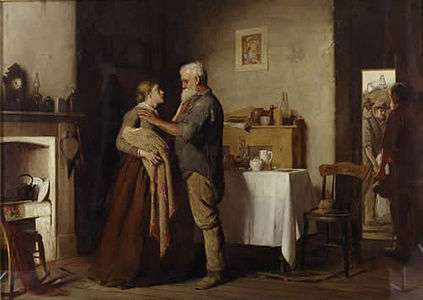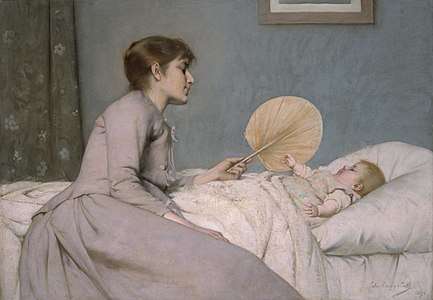John Longstaff
Sir John Campbell Longstaff (10 March 1861 – 1 October 1941) was an Australian painter, war artist and a five-time winner of the Archibald Prize. He was a cousin of Will Longstaff, also a painter, as well as a war artist.

Biography
Longstaff was born at Clunes, Victoria, second son of Ralph Longstaff, storekeeper and Janet (Jessie) Campbell. John was educated at a boarding school in Miners Rest and Clunes State School. He later studied at the Melbourne National Gallery School, after his father initially disapproved of his artistic ambitions.[1] Longstaff's talent was recognised by George Folingsby.[1] He married Rosa Louisa (Topsy) Crocker on 20 July 1887 Powlett Street, East Melbourne.
He won the National Gallery of Victoria's first travelling scholarship for his 1887 narrative painting Breaking the News (which inspired a 1912 film of the same name), and John and his wife sailed from Melbourne for London in September 1887. In January 1888 they travelled to Paris, where John exhibited in the Paris Salon. He later moved to London, where he painted many portraits. He returned to Australia in 1894 and was given several commissions. He occupied a studio at Grosvenor Chambers in Melbourne from 1897 to 1900. The National Gallery of Victoria assumed ownership of The Sirens under terms of the scholarship and bought his large landscape Gippsland, Sunday night, 20 February 1898. He travelled to London again in 1901, where he exhibited with the Royal Academy.
Longstaff was appointed an official war artist with the Australian Infantry Force in the First World War. He made several portraits of officers in the military. On his return to Australia he won several awards and was given distinguished positions, such as his appointment to President of the Victorian Artists Society in 1924 and Trustee of the National Gallery of Victoria in 1927. He was knighted in 1928, the first Australian artist to have had this honour.
His 1929 portrait of the artist Ellis Rowan was the first national portrait of an Australian woman.[2]
The Art Gallery of South Australia holds his portraits of Paris Nesbit and The Artist's Wife.
Biography
His biography Portrait in Youth, written by Nina Murdoch was published in 1948. His 1920 portrait of Nina Murdoch hangs in Reading Room of the National Library, Canberra.[3]
Archibald prize
His Archibald Prize winning pieces:
- 1925 - Portrait of Maurice Moscovitch
- 1928 - Portrait of Dr Alexander Leeper
- 1929 - W A Holman, KC
- 1931 - Sir John Sulman
- 1935 - A B ('Banjo') Paterson
Gallery

 The Young Mother, 1891, National Gallery of Victoria
The Young Mother, 1891, National Gallery of Victoria Gippsland, Sunday night, February 20th, 1898, 1898, National Gallery of Victoria
Gippsland, Sunday night, February 20th, 1898, 1898, National Gallery of Victoria Arrival of Burke, Wills and King at the deserted camp at Cooper's Creek, Sunday evening, 21st April 1861, 1907, National Gallery of Victoria
Arrival of Burke, Wills and King at the deserted camp at Cooper's Creek, Sunday evening, 21st April 1861, 1907, National Gallery of Victoria
References
- Leigh Astbury, 'Longstaff, Sir John Campbell (1861 - 1941)', Australian Dictionary of Biography, Volume 10, MUP, 1986, pp 141–142.
- Percival Serle, ed. (1949). "Longstaff, Sir John". Dictionary of Australian Biography. Angus and Robertson, Sydney. Retrieved 12 July 2007.
- Sydney Morning Herald 6 December 1929
- http://adbonline.anu.edu.au/biogs/A100611b.htm
External links
| Wikimedia Commons has media related to John Longstaff. |
- John Longstaff at Artcyclopedia
- LONGSTAFF, Sir John at the Australian War Memorial
| Awards | ||
|---|---|---|
| Preceded by William Beckwith McInnes |
Archibald Prize 1925 for Portrait of Maurice Moscovitch |
Succeeded by William Beckwith McInnes |
| Preceded by George Washington Lambert |
Archibald Prize 1928 for Portrait of Dr. Alexander Leeper 1929 for W. A. Holman, K.C. |
Succeeded by William Beckwith McInnes |
| Preceded by William Beckwith McInnes |
Archibald Prize 1931 for Sir John Sulman |
Succeeded by Ernest Buckmaster |
| Preceded by Henry Hanke |
Archibald Prize 1935 for A. B. ('Banjo') Paterson |
Succeeded by William Beckwith McInnes |